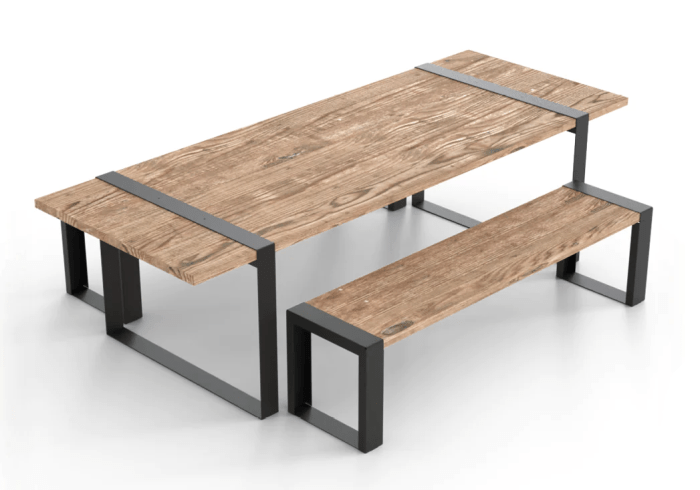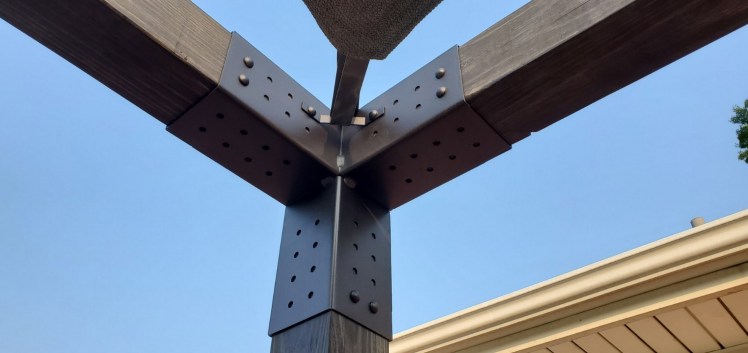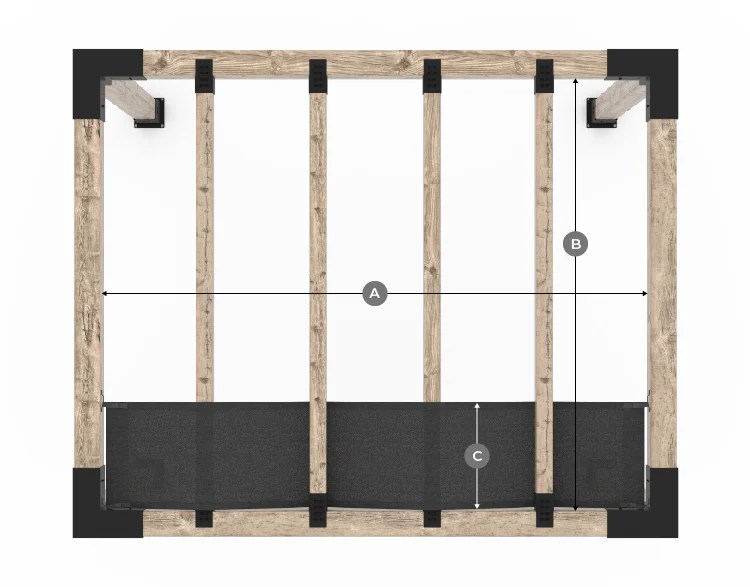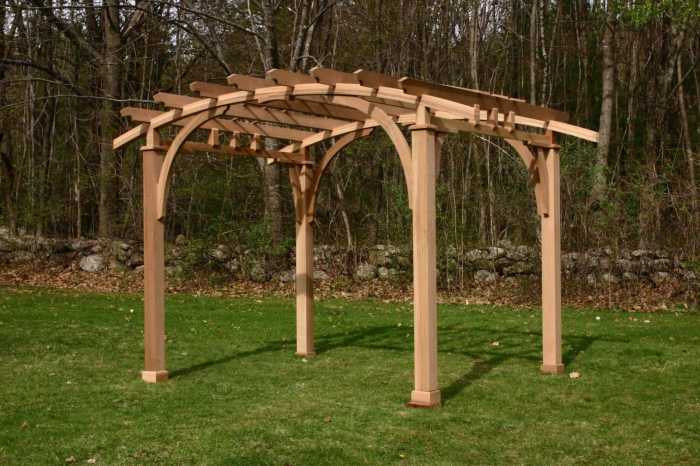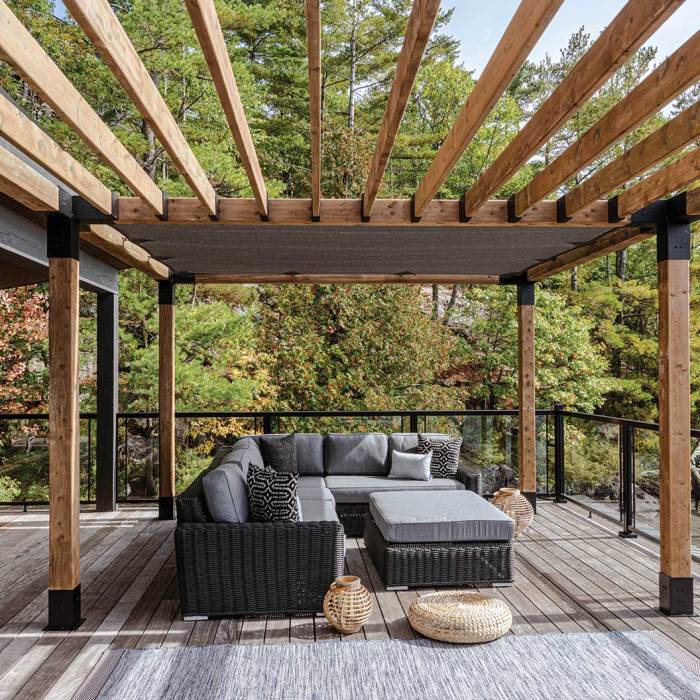Toja Sail Shades A Comprehensive Guide
Toja sail shades offer a stylish and practical solution for shading your home or business. This comprehensive guide explores their features, benefits, installation, and diverse applications. From detailed descriptions of different types and materials to practical installation advice and aesthetic considerations, this resource provides a thorough understanding of toja sail shades, allowing you to make informed decisions about incorporating them into your space.
Toja sail shades are available in a variety of materials, sizes, and designs, catering to diverse architectural styles and preferences. They are not just about blocking sunlight; they are a sophisticated addition that enhances both the aesthetic appeal and functionality of any structure.
Product Description: Toja Sail Shade
Toja sail shades offer a sophisticated and practical solution for managing sunlight and enhancing the aesthetic appeal of any outdoor space. They provide versatile shade options, adapting to diverse architectural styles and functional needs. This section details the key features, types, mounting, specifications, materials, and comparative analysis of various Toja sail shade models.
Toja sail shades are designed for outdoor use, providing both protection from the sun and a visually appealing addition to patios, balconies, and other outdoor living areas. They are adaptable to various environments and can be customized to match individual preferences.
Key Features and Functionalities
Toja sail shades are characterized by their ability to effectively block sunlight, offering a comfortable and shaded environment. Their design allows for adjustable angles and positions, enabling users to customize the amount of shade according to the prevailing sun position and desired level of privacy. This flexibility makes them highly adaptable to changing weather conditions and user needs.
Types of Toja Sail Shades
Various Toja sail shade models are available, catering to different aesthetic and functional requirements. These variations include differences in materials, sizes, and designs.
- Fabric Materials: Toja sail shades are available in a range of fabrics, each with unique properties. Options might include waterproof and UV-resistant polyester, durable acrylics, or breathable sun-resistant canvas. Different materials offer varying levels of shade, water resistance, and durability.
- Sizes and Designs: Toja sail shades come in various sizes, accommodating different outdoor spaces. Design options may include fixed or adjustable angles, allowing for customization of shade coverage. Some models may incorporate decorative elements or custom color options.
Mounting Options and Installation Procedures
The installation procedures for Toja sail shades vary depending on the specific model and the desired mounting location. Common mounting options include wall-mounted, post-mounted, or roof-mounted configurations. Detailed instructions are provided with each model to guide the installation process.
- Wall Mounting: Suitable for areas with a solid wall structure, wall-mounted installation involves attaching the sail shade brackets to the wall using appropriate fasteners. Care should be taken to ensure the brackets are securely fixed to the wall for stability.
- Post Mounting: For structures with posts or pillars, post-mounted sail shades are a practical choice. The shade is anchored to the posts, providing a stable and visually appealing solution. Appropriate anchoring techniques should be employed for safety and durability.
Typical Dimensions and Specifications
Toja sail shades are available in a range of dimensions, varying by model. Specifications such as the sail width, depth, and the height from the ground to the lowest point of the shade are usually provided with each model. Users should consider the dimensions of their outdoor space when selecting a suitable Toja sail shade.
Construction Materials
The construction materials of Toja sail shades are carefully selected to ensure durability and longevity. High-quality fabrics and strong frame components are used to withstand various weather conditions. Frame materials commonly include powder-coated aluminum, ensuring resistance to rust and corrosion.
Comparison of Toja Sail Shade Models
The following table provides a comparative overview of various Toja sail shade models, highlighting their unique attributes and approximate prices. Note that prices are estimates and may vary based on specific features and customization options.
| Model | Material | Size (LxW) | Mounting | Approximate Price |
|---|---|---|---|---|
| SailShade Pro | Waterproof Polyester | 10ft x 15ft | Wall/Post | $1,200 |
| SunScreen Classic | UV-Resistant Canvas | 8ft x 12ft | Wall/Roof | $950 |
| SailShade Luxe | Acrylic | 12ft x 18ft | Roof | $1,500 |
Benefits and Advantages
Toja sail shades offer a compelling range of advantages over traditional shading solutions, improving aesthetics, energy efficiency, and overall comfort. Their unique design and versatile nature make them a practical and attractive choice for various architectural styles. This section delves into the specific benefits and advantages of choosing Toja sail shades.
Toja sail shades provide a distinct advantage over other shading solutions due to their elegant design, adaptability to various architectural styles, and positive impact on energy efficiency. Their aesthetic appeal enhances the visual appeal of any space, while their functional design optimizes comfort and energy conservation.
Enhanced Aesthetic Appeal
Toja sail shades offer a unique and attractive aesthetic compared to other shading options. Their sleek, modern design elements integrate seamlessly into a wide range of architectural styles. For example, a contemporary home can benefit from the clean lines of Toja sail shades, while a traditional farmhouse can use the classic, natural aesthetic for a harmonious touch. The fabric colors and textures further contribute to the overall aesthetic appeal, allowing for personalization and customization. They can be designed to complement the existing design or create a focal point within a space.
Improved Energy Efficiency and Reduced Cooling Costs
Toja sail shades significantly contribute to energy efficiency by reducing solar heat gain. Their ability to block direct sunlight dramatically minimizes heat entering a building, resulting in reduced reliance on air conditioning. Studies show that proper shading solutions can reduce cooling energy consumption by up to 30%. For example, a commercial building equipped with Toja sail shades can experience substantial savings on utility bills, directly impacting its bottom line. This reduced energy consumption translates into tangible financial benefits, showcasing the long-term value proposition of the product.
Improved Comfort Levels
Toja sail shades play a crucial role in improving comfort levels within a space. By regulating the amount of sunlight entering a room, they create a more pleasant and controlled indoor environment. The adjustable design allows for customized control over the amount of light and heat entering a space, creating a more comfortable and adaptable atmosphere for occupants. This dynamic control ensures consistent comfort regardless of the time of day or weather conditions.
Integration with Different Architectural Styles
Toja sail shades are designed to integrate seamlessly into various architectural styles. Their adaptability makes them a versatile choice for diverse projects. The sleek, modern aesthetic of Toja sail shades blends well with contemporary structures, while their classic design elements complement traditional homes. Moreover, the customizable options, such as color and fabric selection, further enhance their integration into diverse architectural aesthetics. Their ability to adapt to varying design sensibilities makes them a practical and stylish choice for homeowners and architects alike.
Environmental Benefits
| Shading Solution | Material Usage | Energy Efficiency | Waste Generation |
|---|---|---|---|
| Toja Sail Shades | Recyclable and sustainable fabrics | High energy efficiency | Minimal waste due to design and recyclability |
| Venetian Blinds | Often non-renewable materials | Moderate energy efficiency | Potential for significant waste generation during production and disposal |
| Exterior Shutters | Varying material usage | Moderate energy efficiency | Waste generation is dependent on the material |
Toja sail shades offer significant environmental advantages compared to traditional shading solutions. Their use of sustainable materials and design contributes to reduced environmental impact throughout their lifecycle. The table above highlights the comparative environmental footprint of Toja sail shades, showcasing their superior sustainability credentials.
Installation and Maintenance
Proper installation and maintenance are crucial for the longevity and optimal performance of Toja sail shades. These steps ensure your shade system operates efficiently, provides the desired sun protection, and minimizes potential issues. Following the guidelines below will greatly contribute to a positive user experience.
Installation Steps
This section articulates the essential steps for installing Toja sail shades. Carefully following these instructions minimizes errors and ensures a safe and successful installation.
- Site Preparation: Thoroughly assess the installation area. Ensure the mounting points are suitable for the chosen shade system. Mark the locations for mounting hardware and confirm the load capacity of the chosen mounting system to avoid any issues later. Clear the installation area of obstructions and debris.
- Hardware Assembly: Assemble the necessary hardware components as per the manufacturer’s instructions. This step typically involves connecting brackets, rods, and other attachments. Carefully review the diagram or assembly guide provided to ensure proper connections.
- Mounting: Secure the mounting hardware to the chosen points. Use appropriate fasteners and torque them to the manufacturer’s specifications. Ensure the mounting hardware is securely fastened and the mounting surface is stable. Proper mounting prevents sagging or shifting over time.
- Shade Installation: Carefully attach the sail shade to the mounting system according to the manufacturer’s guidelines. Verify that the shade is aligned correctly and there are no gaps or misalignments. Ensure the sail shade can be operated smoothly and easily. Check for any potential issues with the operation.
- Final Checks: Perform a thorough inspection of the entire installation. Verify all connections are secure and the shade operates smoothly. Adjust the shade for optimal functionality. Test the operation of the mechanisms and ensure they are free of any obstructions.
Maintenance Procedures
Regular maintenance is key to preserving the aesthetic appeal and performance of your Toja sail shades. These steps ensure longevity and minimize wear and tear.
- Cleaning: Periodically clean the sail shade using a soft-bristled brush or a gentle garden hose. Avoid using harsh chemicals or abrasive materials, which can damage the fabric. Regular cleaning removes dust, dirt, and other debris, maintaining the shade’s appearance.
- Inspection: Regularly inspect the shade for any signs of wear, tear, or damage. Check the mounting hardware for any signs of looseness or corrosion. Promptly address any identified issues to prevent further deterioration. Addressing issues promptly minimizes future problems.
- Lubrication: Lubricate moving parts, such as hinges and tracks, with a suitable lubricant to ensure smooth operation. This step helps maintain the functionality and lifespan of the mechanisms.
- Storage: When the shade is not in use, follow the manufacturer’s instructions for proper storage. This often involves carefully folding and storing the shade in a dry, protected area to avoid damage from moisture and sunlight.
Potential Challenges and Solutions
Troubleshooting potential issues during installation and maintenance is vital.
- Loose Hardware: If hardware becomes loose, tighten the connections using the appropriate tools. Ensure all fasteners are secure. Checking and tightening hardware is important to maintain structural integrity.
- Sagging Shade: If the shade sags, inspect the mounting points and ensure they are properly secured. If necessary, re-tighten the hardware or adjust the tension in the system to correct the issue.
- Malfunctioning Mechanisms: If the shade’s mechanisms malfunction, consult the manufacturer’s instructions or a qualified technician for assistance. Addressing malfunctions is essential to ensure the shade’s smooth operation.
Tools and Materials
The following tools and materials are typically required for installation.
- Screwdrivers (Phillips and flathead)
- Wrench set
- Measuring tape
- Level
- Safety glasses
- Gloves
- Appropriate fasteners (screws, bolts, etc.)
- Lubricant (for moving parts)
Safety Precautions, Toja sail shade
Prioritizing safety during installation is paramount.
- Fall Protection: Use appropriate fall protection equipment if working at heights. This includes harnesses, lanyards, and other safety gear.
- Electrical Safety: Disconnect power sources if working near electrical components. This step is critical to avoid electrical hazards.
- Proper Handling: Handle the sail shade and components carefully to prevent damage. Be cautious when working with heavy objects.
Maintenance Schedule
This table article provides a recommended maintenance schedule for Toja sail shades.
| Task | Frequency |
|---|---|
| Cleaning | Monthly |
| Inspection | Quarterly |
| Lubrication | Semi-annually |
| Hardware Check | Annually |
Applications and Use Cases
Toja sail shades offer a versatile solution for both residential and commercial spaces, enhancing comfort and aesthetics while optimizing light control and energy efficiency. Their adaptable design allows for customization, catering to specific needs and creating tailored solutions for various environments.
Residential Applications
Toja sail shades provide a practical and stylish way to enhance the living experience in residential settings. Their adjustable louvers allow for precise control over sunlight and privacy, creating a personalized atmosphere in each room. They can be integrated seamlessly into patios, balconies, or sunrooms, offering protection from harsh weather and unwanted glare.
- Patios and Decks: Toja sail shades can transform outdoor living spaces into comfortable havens, shielding residents from direct sunlight while maintaining a visual connection with the surroundings. Imagine a homeowner enjoying a meal al fresco, protected from the afternoon sun, while still enjoying the fresh air and views. The soft, diffused light filtering through the sail shades creates a relaxing ambiance, perfect for entertaining guests or enjoying a quiet evening.
- Sunrooms and Conservatories: In sunrooms or conservatories, Toja sail shades can mitigate the intense heat of the summer sun while maintaining the natural light that makes these spaces so appealing. This controlled light allows for optimal plant growth and a comfortable indoor environment, extending the usability of these rooms throughout the year. A homeowner can enjoy the beauty of a conservatory without overheating or compromising the natural light that makes the room special.
- Bedrooms and Living Rooms: In bedrooms, Toja sail shades can create a soothing environment by adjusting the amount of light entering the room. They provide a balance between natural light and privacy, promoting a restful sleep schedule. Similarly, in living rooms, the shades can filter harsh sunlight, creating a more comfortable atmosphere for relaxation or entertainment. Their customizability enables homeowners to tailor the light and shadow patterns to their specific preferences.
Commercial Applications
Toja sail shades offer a practical and aesthetically pleasing solution for a variety of commercial settings, enhancing employee comfort and improving the overall experience for clients.
- Offices: Toja sail shades can effectively control glare and temperature in office spaces, contributing to a more comfortable and productive work environment. In open-plan offices, they can effectively block direct sunlight, reducing eye strain and creating a more focused atmosphere. This improves worker concentration and well-being, leading to higher productivity. Imagine a collaborative workspace with a naturally lit environment, yet protected from harsh sunlight.
- Restaurants and Cafes: By filtering sunlight, Toja sail shades can maintain a comfortable temperature in outdoor dining areas, making the space more appealing and inviting to customers. They offer a balance between natural light and shade, allowing for a pleasant dining experience. Restaurants can extend their outdoor seating season while maintaining a pleasant ambiance.
- Retail Stores: In retail settings, Toja sail shades can improve the visual appeal of products by controlling glare and enhancing the overall store atmosphere. They can create a more inviting and comfortable environment for shoppers, ultimately boosting sales. The use of Toja sail shades allows retailers to maintain visibility and aesthetics while creating a pleasant shopping experience.
Customization and Design
Toja sail shades can be tailored to meet specific needs, enhancing the design and functionality of various spaces. Their customizable nature allows for diverse design elements and layouts, creating a unique look for each project.
- Fabric Options: Toja sail shades offer a variety of fabric options, allowing users to choose colors, patterns, and textures that complement the existing design aesthetic. The choice of fabric significantly influences the overall appearance and functionality of the shade.
- Layout Variations: Different layout configurations can be designed to suit specific needs, such as providing optimal shade for different angles of sunlight. This flexibility ensures the shades effectively address the unique light and shadow patterns of each space.
- Integration with Existing Structures: Toja sail shades can be seamlessly integrated into existing architectural structures, providing a visually appealing and functional addition to the overall design. Their compatibility with various architectural styles and building materials allows for a harmonious blend.
Use Cases Table
| Use Case | Advantages |
|---|---|
| Residential Patio | Improved outdoor comfort, protection from the sun, enhanced ambiance |
| Commercial Office | Increased employee comfort, reduced glare, improved productivity |
| Restaurant Outdoor Seating | Extended seating season, improved customer comfort, enhanced ambiance |
| Retail Store Facade | Improved product visibility, controlled glare, enhanced store aesthetic |
Materials and Construction
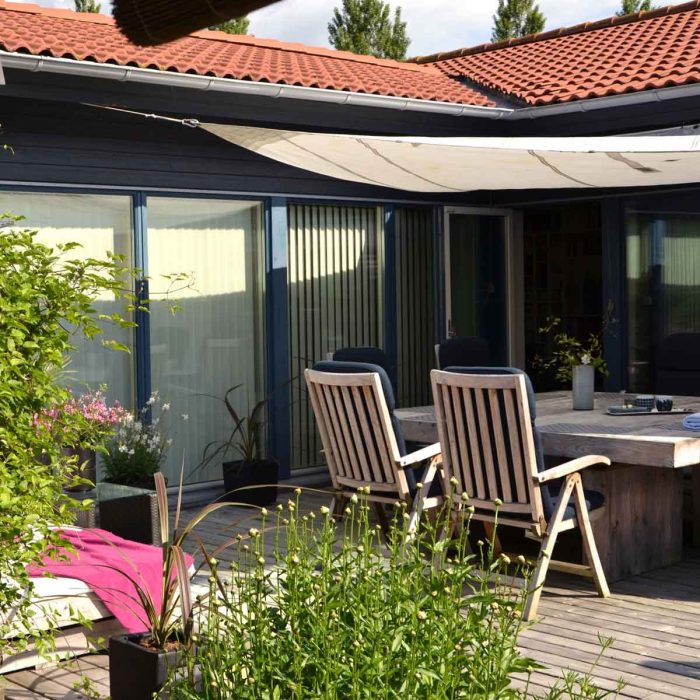
Source: familyhandyman.com
Toja sail shades are meticulously crafted to offer superior protection and longevity. The choice of materials and the precision of the manufacturing process directly impact the shade’s performance, durability, and overall lifespan. This section details the various materials employed in their construction, the manufacturing steps, and the quality control measures implemented.
The materials used in Toja sail shades are carefully selected for their specific properties, such as UV resistance, water resistance, and tensile strength. This ensures that the shades can withstand the elements while maintaining their aesthetic appeal. The manufacturing process, from initial material selection to final assembly, is designed to meet stringent quality standards.
Material Selection
Toja sail shades utilize a combination of high-quality materials to ensure durability and aesthetic appeal. Key materials include high-tenacity polyester fabrics, aluminum frames, and stainless steel hardware. Each material choice is strategically made to complement the others and enhance the overall performance of the shade.
Manufacturing Process
The manufacturing process of Toja sail shades involves several critical steps, each meticulously controlled to ensure optimal quality.
- Material Preparation: Raw materials, such as the polyester fabric, are meticulously inspected and prepared. This includes cleaning, cutting, and treating the fabric to enhance its resistance to UV degradation and water damage.
- Frame Assembly: Aluminum frames are precision-cut and assembled using high-quality stainless steel hardware. Welding and other joining methods are performed with meticulous attention to detail, ensuring structural integrity.
- Fabric Attachment: The prepared fabric is carefully attached to the frame using a robust and durable stitching method. This step is crucial for ensuring the shade’s ability to withstand wind and weather.
- Quality Control Inspection: Each stage of the process undergoes rigorous quality control checks. This includes inspections for material defects, frame alignment, and stitching quality.
- Final Assembly: The completed shade undergoes final assembly and packaging, ensuring it’s ready for shipment and installation.
Quality Control Measures
Rigorous quality control measures are in place at every stage of the manufacturing process. This ensures the Toja sail shade meets stringent standards for durability, functionality, and safety. This includes testing for tensile strength, water resistance, and UV resistance. Furthermore, independent third-party audits are performed to ensure compliance with industry best practices.
- Material Testing: Each material batch is tested for its tensile strength, tear resistance, and resistance to UV degradation.
- Frame Integrity Testing: Aluminum frames are subjected to rigorous stress tests to ensure their structural integrity and resistance to bending or deformation.
- Stitching Quality Checks: Stitching strength and uniformity are inspected to guarantee long-term durability.
- Water Resistance Testing: The shade’s ability to withstand rain and moisture is evaluated through controlled water exposure tests.
- UV Resistance Testing: The fabric’s resistance to UV degradation is measured using accelerated weathering testing methods.
Durability and Lifespan Comparison
The durability and lifespan of Toja sail shades are directly influenced by the materials used. High-tenacity polyester fabrics, when properly treated, can provide a substantial lifespan of 10-15 years or more, surpassing other similar materials.
Material Comparison Table
| Material | Strength | Water Resistance | UV Resistance |
|---|---|---|---|
| High-Tenacity Polyester | High | Excellent | Excellent |
| Acrylic Fabric | Medium | Good | Good |
| Cotton Canvas | Low | Poor | Fair |
Visual Representation
Toja sail shades offer a sophisticated aesthetic enhancement for any space, seamlessly blending functionality with visual appeal. Their design flexibility allows for a variety of customization options, catering to diverse architectural styles and personal preferences. The visual characteristics of Toja sail shades are key to their overall impact and integration into a given environment.
Visual Characteristics
Toja sail shades are available in a range of colors, from neutral tones like beige and gray to vibrant hues like teal and crimson. These colors can be tailored to complement existing color schemes or introduce a pop of personality. The material’s texture, often a subtle weave or a smooth finish, adds depth and visual interest. Shapes are versatile, ranging from simple rectangles to more elaborate curves and angular designs, offering choices that can match the building’s architectural style. The interplay of light and shadow created by the sail shades can dramatically alter the ambiance of a space, lending a unique character to the overall design.
Customization Options
Toja sail shades offer extensive customization options to match specific design requirements. Color palettes can be selected from a comprehensive catalog of options, or custom colors can be incorporated. Furthermore, patterns can be integrated into the design to provide unique visual interest. This level of customization allows for the integration of Toja sail shades into a variety of architectural styles and aesthetic preferences.
Incorporating Toja Sail Shades
The versatility of Toja sail shades extends beyond their aesthetic appeal. By strategically positioning them in a space, a unique ambiance can be cultivated. For example, a series of Toja sail shades with a vibrant teal color, positioned over a patio area, can transform the outdoor space into a relaxing retreat. Similarly, a set of sail shades with a minimalist, light gray design can integrate seamlessly into a modern home’s living room. Their adaptable nature makes them a valuable tool in creating custom spaces.
Illustrative Examples
To illustrate the versatility of Toja sail shades in different architectural styles, consider the following examples:
- Modern Architecture: Imagine a sleek, contemporary home with large windows. Toja sail shades in a muted gray, with a simple, rectangular shape, would blend seamlessly with the minimalist design. The clean lines and subtle texture of the shades would enhance the modern aesthetic.
- Mediterranean Style: A Mediterranean-style villa with a bright, open-air patio would benefit from Toja sail shades in a warm, terracotta color. The rich hue and textured weave would complement the vibrant colors and materials of the building’s architecture, adding a touch of Mediterranean charm. The interplay of light and shadow created by the sail shades could enhance the warm ambiance of the patio area.
- Traditional Farmhouse: A traditional farmhouse with exposed beams and natural wood accents would be well-suited to Toja sail shades in a light beige or cream color. The neutral tones would complement the existing elements of the house and provide a classic, welcoming feel.
These illustrations highlight the ability of Toja sail shades to adapt to a wide range of architectural styles, enhancing their aesthetic appeal and creating a unique ambiance.
Conclusion
In conclusion, toja sail shades represent a versatile and effective shading solution. This guide has highlighted their diverse applications, from residential settings to commercial spaces. Their aesthetic appeal, energy efficiency, and ease of integration into different architectural styles make them a compelling choice. Whether you’re looking for a simple solution to reduce glare or a more elaborate design element, toja sail shades offer a wide range of options to enhance your space. With careful consideration of materials, installation, and maintenance, you can maximize the benefits of these versatile shading solutions for years to come.
